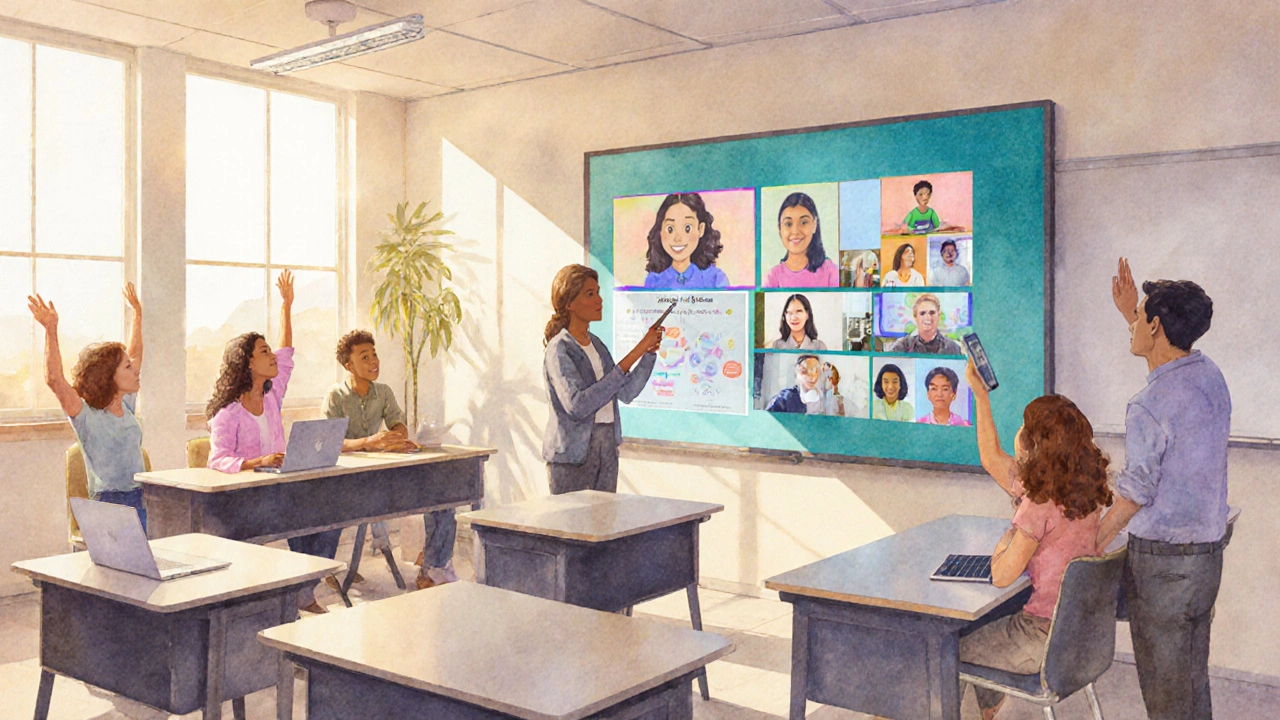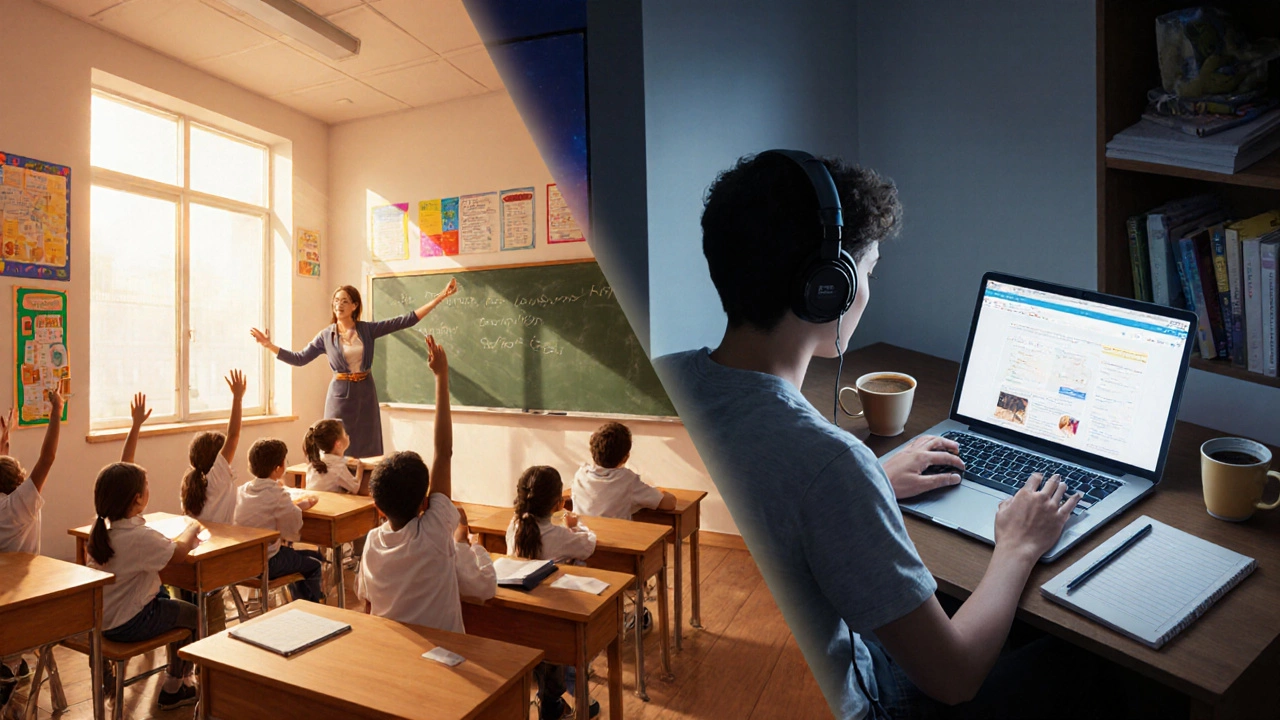Learning Mode Selector
Choose the option that best matches your situation to find which learning format works best for you.
Your Learning Profile
Your Recommendation
Key Takeaways
- in-school learning often outperforms online settings in social interaction and hands‑on practice.
- Online learning shines when flexibility, resource variety, and personalized pacing matter.
- Hybrid models can capture the best of both worlds, but they need strong coordination.
- Student engagement, learning outcomes, and digital equity are the decisive factors.
- Choose based on individual goals, local infrastructure, and support structures.
What Is In-school Learning?
When we talk about In-school learning is the traditional classroom experience where students gather in a physical space under the direct supervision of a teacher. It typically follows a set schedule, uses a shared syllabus, and relies on face‑to‑face interaction for instruction, discussion, and assessment. This model has been the backbone of formal education for centuries, shaping everything from primary schools to university lecture halls.
What Is Online Learning?
Online learning is any instruction delivered via the internet, using platforms like Zoom, Moodle, or proprietary learning management systems. Learners access video lectures, interactive quizzes, and digital resources from any device with a connection, often on their own timetable. Since the pandemic, this mode has exploded, offering courses from global universities to niche skill workshops.

How They Stack Up on Core Factors
| Factor | In-school Learning | Online Learning |
|---|---|---|
| Student Engagement | High - immediate feedback, group work, hands‑on activities. | Variable - depends on platform design and self‑discipline. |
| Learning Outcomes | Strong for subjects requiring labs, performance, or equipment. | Comparable for theory‑based content; may lag for practical skills. |
| Social Interaction | Rich - peer networking, extracurricular clubs, spontaneous talk. | Limited - chat rooms and discussion boards, but fewer informal bonds. |
| Access to Resources | Physical books, labs, teacher’s presence on‑site. | Vast digital libraries, recorded lectures, global experts. |
| Assessment Methods | Live exams, oral presentations, practical demonstrations. | Online quizzes, automated grading, project‑based portfolios. |
| Flexibility | Low - set timetables, commuting required. | High - learn anytime, anywhere, often self‑paced. |
| Cost | Infrastructure heavy - building maintenance, transport. | Potentially lower tuition, but needs reliable internet and devices. |
When In-school Beats Online
There are clear scenarios where the classroom edge is hard to ignore. Student engagement spikes when learners can ask spontaneous questions, engage in live debates, and receive immediate correction. Science labs, art studios, and physical education rely on equipment and space that a screen can’t replicate. Young children also benefit from structured routines and supervision that help develop focus and social skills.
Moreover, people in regions with poor broadband suffer from the digital divide -the gap between those who have reliable internet and those who don’t. For them, a brick‑and‑mortar school remains the most dependable path to education.
When Online Beats In-school
Flexibility is the crown jewel of online learning. It lets working parents, part‑time students, and professionals juggle study with jobs or family duties. The digital ecosystem offers a sheer volume of up‑to‑date resources, from open‑access journals to interactive simulations, often at lower cost.
Personalized pacing is another win. Adaptive platforms can present easier material when a learner struggles and accelerate when they master concepts quickly. This tailored approach can improve learning outcomes measured by assessment scores and skill retention. for motivated self‑directed students.

Hybrid and Flexible Models
Many schools now blend the two worlds, creating a hybrid learning model that schedules in‑person weeks for labs and group projects, then switches to online modules for theory and homework.
This approach leverages the social benefits of classrooms while retaining the resource richness of the internet. Success hinges on clear communication, reliable tech infrastructure, and teachers trained to shift seamlessly between modes.
Practical Tips for Choosing the Right Mode
- Assess your goals. If you need hands‑on certification (e.g., nursing, engineering), prioritize in‑school options.
- Check access to reliable internet. Without it, online courses become a headache.
- Evaluate your learning style. Visual‑self‑pacers thrive online; auditory‑social learners often need face‑to‑face cues.
- Consider cost and time. Factor in commuting, childcare, and technology expenses.
- Look for support services. Both models should offer tutoring, counseling, and technical help.
- If possible, test a hybrid pilot. Many institutions offer short workshops that blend both formats.
Remember, the "better" choice isn’t universal-it’s personal. Use the checklist above to match the environment to your circumstances.
Frequently Asked Questions
Does online learning affect graduation rates?
Studies from the OECD in 2023 show that graduation rates in fully online programs are about 5‑7% lower than traditional tracks, mainly due to lower engagement and higher dropout among students lacking strong self‑regulation.
Can I get the same qualifications online?
Yes. Accrediting bodies in the US, UK, and New Zealand recognise many online degrees as equivalent, provided the institution meets quality standards and uses proctored assessments.
How does social interaction differ between the two modes?
In‑person classrooms foster spontaneous conversations, group projects, and extracurricular clubs. Online settings rely on scheduled breakout rooms and forums, which can feel less natural and often require deliberate effort to build community.
What technology do I need for effective online learning?
A stable broadband connection (minimum 10Mbps download), a modern laptop or tablet with a webcam, and a headset for clear audio. Many platforms also support mobile apps, but a larger screen improves note‑taking.
Is hybrid learning more expensive?
Costs vary. Some schools charge a blended tuition that sits between full‑time campus fees and pure online rates. Savings may come from reduced commuting and textbook expenses, while technology upgrades can add extra cost.


Write a comment